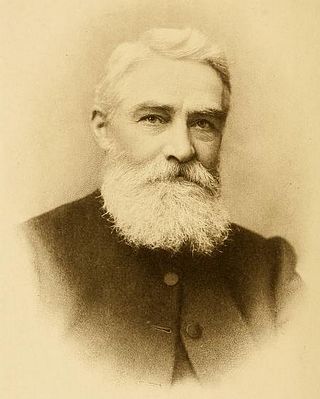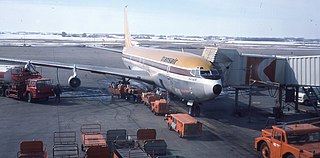Related Research Articles

Robert Joseph Flaherty, was an American filmmaker who directed and produced the first commercially successful feature-length documentary film, Nanook of the North (1922). The film made his reputation and nothing in his later life fully equaled its success, although he continued the development of this new genre of narrative documentary with Moana (1926), set in the South Seas, and Man of Aran (1934), filmed in Ireland's Aran Islands. Flaherty is considered the "father" of both the documentary and the ethnographic film.

Edmund James Peck, known in Inuktitut as Uqammaq, was an Anglican missionary in the Canadian North on the Quebec coast of Hudson Bay and on Baffin Island. He founded the first permanent mission on Baffin Island, Nunavut. He developed Inuktitut syllabics, derived from the Cree syllabary and the first substantial English-Inuktitut dictionary.
Pacific Western Airlines Ltd (PWA) was an airline that operated scheduled flights throughout western Canada and charter services around the world from the 1950s through the 1980s.

The James Bay Project refers to the construction of a series of hydroelectric power stations on the La Grande River in northwestern Quebec, Canada by state-owned utility Hydro-Québec, and the diversion of neighbouring rivers into the La Grande watershed. It is located between James Bay to the west and Labrador to the east, and its waters flow from the Laurentian Plateau of the Canadian Shield. The project covers an area the size of New York State and is one of the largest hydroelectric systems in the world. It has cost upwards of US$20 billion to build and has an installed generating capacity of 16,527 megawatts. If fully expanded to include all of the original planned dams, as well as the additional James Bay II projects, the system would generate a total of 27,000 MW, making it the largest hydroelectric system in the world. It has been built since 1974 by James Bay Energy (SDBJ) for Hydro-Québec.

The Sisters of Charity of Montreal, formerly called The Sisters of Charity of the Hôpital Général of Montreal and more commonly known as the Grey Nuns of Montreal, is a Canadian religious institute of Roman Catholic religious sisters, founded in 1737 by Marguerite d'Youville, a young widow.
Treaty Five is a treaty that was first established in September, 1875, between Queen Victoria and Saulteaux and Swampy Cree non-treaty band governments and peoples around Lake Winnipeg in the District of Keewatin. Much of what is today central and northern Manitoba was covered by the treaty, as were a few small adjoining portions of the present-day provinces of Saskatchewan and Ontario. The Treaty was completed in two rounds. The first was from September 1875 to September 1876. The Crown intended in 1875 to include only "the Indians [east and west] of Lake Winnipeg for the surrender of the Territory uncovered by previous treaties" including "the proposed migration of the Norway House band". Pimicikamak territory was north of the lake. It was included by accident or design of Tepastenam attending the Norway House signing. Additional peoples and groups signed on between 1908 and 1910.
The James Bay and Northern Quebec Agreement is an Aboriginal land claim settlement, approved in 1975 by the Cree and Inuit of northern Quebec, and later slightly modified in 1978 by the Northeastern Quebec Agreement, through which Quebec's Naskapi First Nation joined the agreement. The agreement covers economic development and property issues in northern Quebec, as well as establishing a number of cultural, social and governmental institutions for Indigenous people who are members of the communities involved in the agreement.

Whapmagoostui is the northernmost Cree village in Quebec, Canada, located at the mouth of the Great Whale River on the coast of Hudson Bay in Nunavik. About 906 Cree with about 650 Inuit, living in the neighbouring village of Kuujjuarapik. The community is accessible only by air and, in late summer, by boat. Whapmagoostui is about 250 km (160 mi) north of the nearest Cree village, Chisasibi.

Calm Air International LP. is a full service airline, offering passenger, charter and freight services in northern Manitoba and the Kivalliq Region of Nunavut. It is owned by Exchange Income Corporation with its main base in Winnipeg, Manitoba.
Indigenous police services in Canada are police forces under the control of a First Nation or Inuit government. The power of Indigenous governments to establish independent police services varies, and only First Nations and Inuit communities governed by the Indian Act can establish their own police forces. Métis governments, First Nations, and Inuit governments that have completed the comprehensive land claims process can only contract police services to a third party police force. The powers of Indigenous police services also vary, and some cannot complete criminal investigations without outside consultation or maintain specialized resources, such as police dogs or crime labs.

Transair was an airline based in Canada. It was purchased by Pacific Western Airlines in 1979. Transair's operational headquarters was located at the Winnipeg International Airport in Manitoba.
Ellen Church was the first female flight attendant. A trained nurse and pilot, Church wanted to pilot commercial aircraft, but those jobs were not open to women. Still wanting to fly, Church successfully worked to convince Boeing Air Transport that using nurses as flight-stewardesses would increase safety and help convince passengers that flying was safe. Their first flight took off on May 15, 1930.
The following is an alphabetical list of topics related to Indigenous peoples in Canada, comprising the First Nations, Inuit and Métis peoples.
The Mathias Colomb Cree Nation (MCCN) —also known as Mathias Colomb First Nation, Mathias Colomb (Cree) First Nation, and Pukatawagan/Mathias Colomb Cree Nation—is a remote First Nations community in northern Manitoba, located 210 km (130 mi) north of The Pas and 819 km (509 mi) northwest of Winnipeg, Manitoba.
The Indigenous Music Awards, formerly called the Aboriginal Peoples' Choice Music Awards, is an annual Canadian music award, given out to Indigenous people who are in the music industry.

The Indian hospitals were racially segregated hospitals, originally serving as tuberculosis sanatoria but later operating as general hospitals, for indigenous peoples in Canada which operated from the late 19th to the late 20th century. The hospitals were used to isolate Indigenous tuberculosis patients from the general population because of a fear among health officials that "Indian TB" posed a danger to the non-indigenous population. Many of these hospitals were located on Indian reserves, and might also be called reserve hospitals, while others were in nearby cities.
Julie Flett is a Cree-Métis author and illustrator, known for her work in children's literature centered around the life and cultures of Indigenous Canadians. Flett is best known for her illustrations in books such as Little You, and When We were Alone, as well as for her written work in books such as Birdsong. Many of Flett's books are bilingual, and written in a combination of English, Michif, and Cree, and serve as an introduction to Michif and Cree for English-speaking readers. Flett's works are critically successful and have been awarded the Governor General's Literary Award and the TD Canadian Children's Literature Award.
Mini Aodla Freeman is an Inuk playwright, writer, poet and essayist.

Karoo Ashevak was an Inuk sculptor who lived a nomadic hunting life in the Kitikmeot Region of the central Arctic before moving into Spence Bay, Northwest Territories in 1960. His career as an artist started in 1968 by participating in a government-funded carving program. Working with the primary medium of fossilized whale bone, Ashevak created approximately 250 sculptures in his lifetime, and explored themes of shamanism and Inuit spirituality through playful depictions of human figures, angakuit (shamans), spirits, and Arctic wildlife.
Ann Thomas Callahan was a Canadian Cree nurse. She was one of the first Indigenous graduates of the Winnipeg General Hospital's nursing school.
References
- 1 2 3 4 5 6 7 8 9 "Anniapik Weetaltuk, The Story of Canada's First Indigenous Flight Attendant - Royal Aviation Museum of Western Canada". royalaviationmuseum.com. 2019-06-21. Retrieved 2022-06-08.
- ↑ "Weetaltuk, Eddy | Inuit Literatures ᐃᓄᐃᑦ ᐊᓪᓚᒍᓯᖏᑦ Littératures inuites". inuit.uqam.ca. Retrieved 2022-06-08.
- 1 2 Patrick, Donna; Morris, Marika; Etitiq, Qauyisaq (2022). Stern, Pamela (ed.). The Inuit World. Routledge. ISBN 978-0-367-22539-1.
- ↑ Weetaltuk, Eddy (2017). From the Tundra to the Trenches. University of Manitoba Press. ISBN 978-0-88755-822-1.